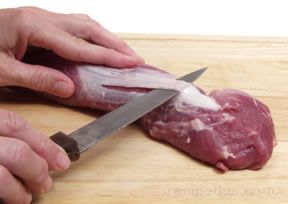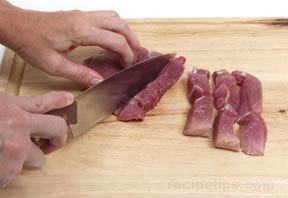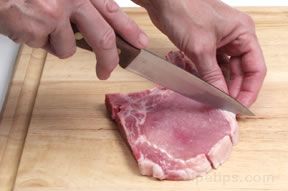|
The first thing to do before starting any kind of trimming process is to be sure that the knives to be used are sharp. This will make the process go more smoothly. Dull knives are not safe and will produce poor cuts. Shown below are some of the trimming processes that are commonly used.
|

|
|
Trim Off Fat - A recipe may suggest that all fat be trimmed from the surface or edges of the cut. If so, use a sharp knife and trim off the outside layer of fat. |
|
Any cut that is going to be roasted can have up to ¼ inch layer of fat left on the surface to prevent the meat from becoming too dry. If the cut is a chop or steak that will be grilled, it is best to leave a small amount of fat on the cut and slit it at one inch intervals to prevent it from curling up while cooking.
|
|
Trim Tenderloin - When preparing a pork tenderloin, trim off any excess fat that is surrounding the meat. Once the excess fat has been trimmed off, the silverskin must be removed. The silverskin is the thin shiny membrane attached to the tenderloin.
|
|

|
|
To remove, slip the tip of your knife under the silvery skin and start slicing back and forth with the sharp edge of the blade angled upward, keeping the membrane tight as you are cutting. Continue to slice the skin off in this manner until all the skin is removed. If this shiny membrane layer is not removed it will shrink during cooking and cause an odd shaped roast, which may also result in a roast that is not cooked evenly.
|
|
Trim Cubes and Strips - Cubes and strips can be trimmed from other cuts, such as a steak or tenderloin and used for kabobs and stir frying.
|

|
|
First trim off excess fat. Trim the meat into 1 to 1 ½ inch cubes for kabobs. |

|
|
If cubes are to be use for kabobs and will be marinated, they can be butterflied to allow the cubes to absorb more of the flavor from the marinade. After cutting cubes for kabobs, butterfly each one by cutting through the center, leaving enough to hold the cube together. Marinate and then place on the skewer as a whole cube. |
|
When trimming a steak or tenderloin into strips for stir frying, cut into thin slices, cutting across the grain. Tenderloins are also trimmed across the grain into thick slices forming tenderloin medallions.
|
|

|
|
Trim Edges - Cuts such as ham steaks, Canadian bacon, and some chops have a layer of fat or rind around the outer edge that can cause the cut to curl up while cooking. To prevent the curling, slice the edges of fat or rind about every inch before starting to cook.

|
Tips for Trimming Meat:
- Dry meat off with a paper towel before trimming to prevent it from slipping around while cutting.
- When trying to cut thin slices, it is easier if you put the meat into the freezer for 30 minutes to an hour before slicing to help firm it up or if meat was frozen, slice before it is completely thawed.
- When trimming or cutting any meat that requires you to hold the meat in place with your fingers, be sure that your fingertips are curved in toward the palm of your hand. Holding them in this manner will prevent them from getting in the way of the blade of the knife.
|

